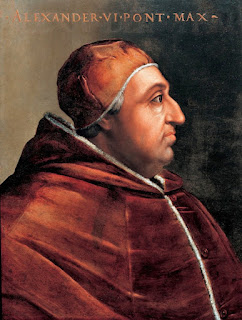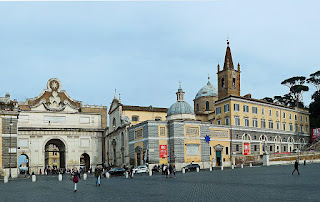Mother of Lucrezia and Cesare Borgia was figure of influence
Vannozza dei Cattanei, who was for many years the chief mistress of Cardinal Rodrigo de Borgia - later Pope Alexander VI - was born on this day in 1442 in Mantua.
Vannozza dei Cattanei hailed from
an aristocratic family in Mantua
Herself from the aristocratic Candia family, Vannozza - baptised as Giovanna de Candia - grew up to be a beautiful woman but also a successful businesswoman, acquiring a number of osterie - inns - after she moved to Rome.
In 15th century Italy, it was not unusual for cardinals and popes to have mistresses, despite Holy Orders coming with a vow of celibacy. Before her relationship with Rodrigo de Borgia, Vannozza allegedly was mistress to Cardinal Giuliano della Rovere, the future Pope Julius II and a rival to Borgia in the 1492 papal election that he won.
Rodrigo made no attempt to hide his sexual dalliances, acquiring the nickname Papa Cattivo - the naughty pope - not only for his promiscuity but his questionable morals in other areas, with allegations that he was involved in bribery and extortion on his rise to the top, and rumours that he poisoned some of his rivals.
Unusually, compared with other popes and cardinals who flouted the rules, Borgia openly acknowledged the children that Vannozza bore him during their relationship, which is thought to have lasted between 20 and 25 years, providing for them financially and having a significant influence over their lives.
The eldest, Cesare, born in 1475, became a cardinal and as leader of the Papal armies captured large amounts of territory that were added to the Pope’s empire. Niccolò Machiavelli’s The Prince, the treatise on power that was written as a kind of reference point for new princes and royals, was influenced by Cesare’s lust for power.
 |
| Pope Alexander VI is thought to have fathered four children with Vannozza |
Lucrezia, meanwhile, was forced to marry three times to elevate Rodrigo’s own status and acquire land and wealth. She took lovers of her own and there were rumours that Giovanni was in fact her own son, the product of an affair with her father's chamberlain.
Vannozza herself had to agree to marriages arranged by Borgia, first to Domenico d'Arignano, an officer of the church, then Giorgio di Croce, for whom Borgia had procured a position as apostolic secretary, and later Carlo Canale, the warden of a papal jail.
Her relationship with Rodrigo Borgia is thought to have changed after she turned 40 and Borgia’s passion for her had diminished by the time he was elevated to Pope in 1492. The care of all her children was entrusted to others in Borgia’s circle, although she remained part of it herself as a sort of matriarchal figure and her former lover sought her counsel as Pope.
He continued to support her financially and by the time she died in 1518, at the age of 76, she had acquired a considerable portfolio of property around the city.
Vannozza outlived Rodrigo de Borgia by 15 years yet despite the nature of their relationship she was granted a public funeral, recognised by Pope Leo X as the widow of Alexander VI. She was buried in the Church of Santa Maria del Popolo, near her son, Giovanni, after a ceremony attended by the Papal Court.
Travel tip:
The skyline of Mantua has changed little since it
was the Renaissance seat of the Gonzaga family
The small, historic city of Mantua in Lombardy, which can be found approximately 150km (93 miles) southeast of Milan along the Po Valley, is flanked on three sides by artificial lakes created in the 123th century as the city’s defence system, filled with water from the Mincio river, a tributary of the Po. There was a fourth lake, which meant the city was once surrounded by water, but it dried up in the 18th century and never replenished. It was traditionally the seat of the Gonzaga family, who established a court with a heavy emphasis on music, art and culture. The city has a number of architectural treasures and elegant palaces, while the skyline of its historic old centre has changed little since Renaissance times. At its heart is Piazza Mantegna, where the 15th century Basilica of Sant’Andrea houses the tomb of the artist, Andrea Mantegna. Inside the Palazzo Ducale, the seat of the Gonzaga family between 1328 and 1707, the Camera degli Sposi is decorated with frescoes by Mantegna.
Travel tip:
The Church of Santa Maria del Popolo is in Piazza
del Popolo, adjoining Porta del Popolo
The Church of Santa Maria del Popolo is a minor basilica in Rome that stands on the north side of Piazza del Popolo, hemmed in between the Pincian Hill and Porta del Popolo, one of the gates in the Aurelian Wall, its position making it the first church encountered by many travellers arriving in the city. The original church was founded by Pope Paschal II in 1099. The existing structure was built largely between 1472 and 1477 as part of an urban renovation programme instigated by Pope Sixtus IV. A trio of great architects - Andrea Bregno, Donato Bramante and Gian Lorenzo Bernini - contributed to its design and are among those whose works can be found inside, along with Raphael, Caravaggio, Alessandro Algardi, Pinturicchio and Guillaume de Marcillat.
Also on this day:
1478: The birth of Giulio d’Este of Ferrara
1814: The founding of the Carabinieri police force
1928: The birth of Mafia mobster and ‘pentito’ Tommaso Buscetta
1974: The birth of racing driver Jarno Trulli






.jpg)


